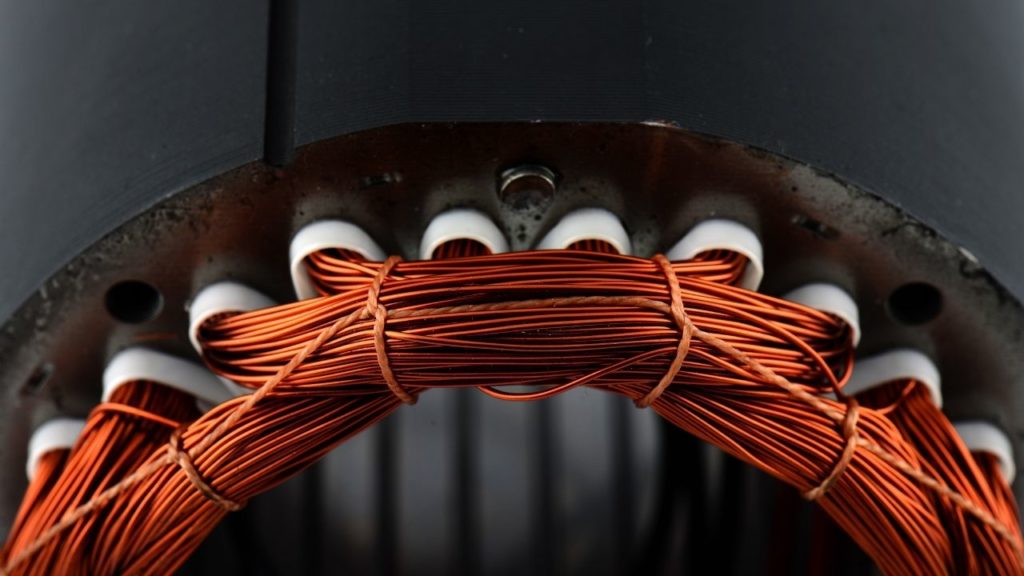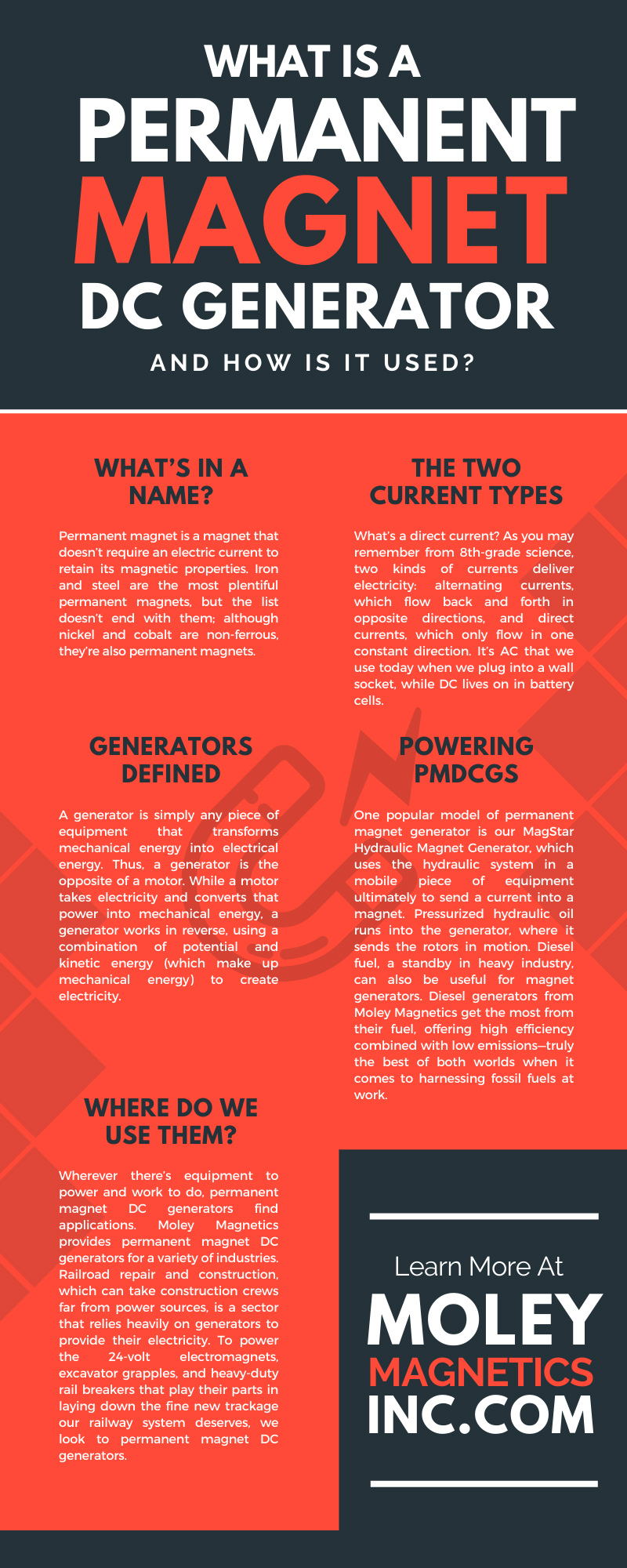
What Is a Permanent Magnet DC Generator and How Is It Used?
Heavy industrial work needs electromagnets. Electromagnets, of course, need electricity. Where does that electricity come from? In many cases, it doesn’t come from a three-pronged plug, a wall socket, and more than a few yards of an extension cord. Powering them isn’t like plugging in a vacuum cleaner—running this machinery in the absence of a traditional alternating current requires you to get creative.
As it happens, we can derive the power we need for electromagnets from some well-placed sets of permanent magnets. By constructing a device that harnesses magnetism and movement, we can create and move a direct current of electricity straight to our electromagnets and other machinery. This device is called a permanent magnet DC generator. But what is a permanent magnet DC generator, and how is it used in an industrial setting? We’ll take a look at one of the most indispensable pieces of equipment on construction sites, demolition sites, recycling facilities, and anywhere else where people work with machinery and metals to get the job done.
What’s in a Name?
“Permanent magnet direct-current generator.” That’s a mouthful. Let’s break it down, piece by piece—the name, that is. A permanent magnet is a magnet that doesn’t require an electric current to retain its magnetic properties. Iron and steel are the most plentiful permanent magnets, but the list doesn’t end with them; although nickel and cobalt are non-ferrous, they’re also permanent magnets. Neodymium, a rare-earth element, forms a powerfully magnetic alloy when in concert with iron and boron. Industries use permanent magnets to sort and separate materials on a grand scale and in hard drives and motors on smaller scales. Permanent magnets also play a role in generators, where magnetism powers the rotor (the moving parts) within a stator (the stationary part).
The Two Current Types
What’s a direct current? As you may remember from 8th-grade science, two kinds of currents deliver electricity: alternating currents, which flow back and forth in opposite directions, and direct currents, which only flow in one constant direction. Inventors Thomas Edison and Nikola Tesla engaged in a high-pitched “current war” to determine which form was better. Tesla claimed high-voltage alternating current was more effective, while Edison believed AC was dangerous vis-à-vis his safer direct current. This war culminated in the public electrocution of an elephant to demonstrate alternating current’s hazardousness. Nonetheless, it’s AC that we use today when we plug into a wall socket, while DC lives on in battery cells.
Generators Defined
That leaves us with generation. A generator is simply any piece of equipment that transforms mechanical energy into electrical energy. Thus, a generator is the opposite of a motor. While a motor takes electricity and converts that power into mechanical energy, a generator works in reverse, using a combination of potential and kinetic energy (which make up mechanical energy) to create electricity. This mechanical energy comes from permanent magnets.
Powering PMDCGs
Generators aren’t perpetual-motion machines. Before the magnets can transform mechanical energy into electricity, they need something to get them going. The wide-ranging Moley Magnetics catalog features several models of permanent magnet generators with varying power sources you can use to get the juice you need on your site. One popular model of permanent magnet generator is our MagStar Hydraulic Magnet Generator, which uses the hydraulic system in a mobile piece of equipment ultimately to send a current into a magnet. Pressurized hydraulic oil runs into the generator, where it sends the rotors in motion. This creates a direct current that, in turn, powers an electromagnet for lifting, moving, and sorting. The generated power allows construction and demolition crews to use heavy machinery without access to an alternating-current source. After all, job sites rarely have a place to plug equipment.
Diesel fuel, a standby in heavy industry, can also be useful for magnet generators. Diesel generators from Moley Magnetics get the most from their fuel, offering high efficiency combined with low emissions—truly the best of both worlds when it comes to harnessing fossil fuels at work. The MagStar Diesel Magnet Generator set includes a 12-gallon fuel tank, meaning that refueling won’t be an ongoing concern. Belt-driven generators don’t have diesel engines or hydraulic lines. Instead, they harness the mechanical energy from other sources of force. This even includes unorthodox ones, such as windmills or bicycles, that power the generator. However, on a job site, belt-driven generators are likely to use diesel fuel as well.
Where Do We Use Them?
Wherever there’s equipment to power and work to do, permanent DC magnet generators find applications. Moley Magnetics provides permanent DC magnet generators for a variety of industries. Railroad repair and construction, which can take construction crews far from power sources, is a sector that relies heavily on generators to provide their electricity. To power the 24-volt electromagnets, excavator grapples, and heavy-duty rail breakers that play their parts in laying down the fine new trackage our railway system deserves, we look to permanent magnet DC generators.
Demolition crews, which tear down the buildings whose useful lives have ended and salvage the valuable metals within, couldn’t do it without PMDCGs powering the electromagnets that sort and separate metals. They certainly need them in the often tight quarters of demolition sites where power sources can be few and far between. The scrap and recycling industries, which further sort and process metals to keep them in circulation, are frequent customers when it comes to generators. These industries use the generators to supplement power sources at facilities and assist in recovering metals while workers are in the field. Whether they use hydraulic power, diesel fuel, or a belt-driven secondary power source, you’ll find permanent magnet DC generators hard at work, with many of them coming from Moley Magnetics and our partners.
Let’s Start Generating
With a clearer understanding of what a permanent magnet DC generator is and how it’s used in myriad industrial applications, you can see why you need them on your job site. Browse our catalog of permanent magnet generators and find the model that’s right for your facility and crew. It’s amazing what magnets—and Moley Magnetics—make possible. See our products on YouTube.


